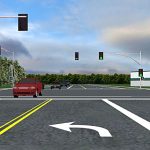Connected and autonomous vehicle (CAV) technology and information may greatly help reduce congestion, especially in urban settings. However, currently there is no real-time, reliable, and multimodal approach for controlling the timing of signalized intersections in a connected or semi-connected arterial or urban street network. In addition, research is needed to explore the ability to communicate basic traffic signal controller information such as signal phase and timing (SPaT) to connected vehicles to allow them to directly respond to and coordinate with ongoing signal operations. Because WSDOT maintains 1,000 signalized intersections throughout the state, it is important for WSDOT to plan for this emerging and revolutionary technology and to develop ways to use the additional information that CAVs will provide to improve traffic operations. This project will help WSDOT to identify technological issues and requirements of integrating CV hardware in existing traffic signal systems.
Principal Investigator: Ali Hajbabaie, Civil and Environmental Engineering, WSU
Sponsor: WSDOT
WSDOT Technical Monitor: Ted Bailey
WSDOT Project Manager: Doug Brodin
Scheduled completion: December 2020


